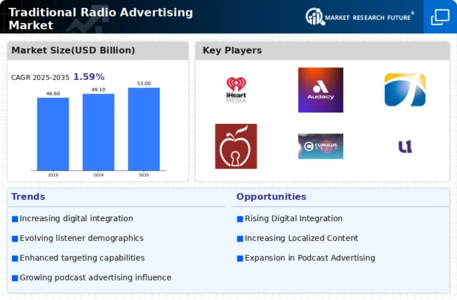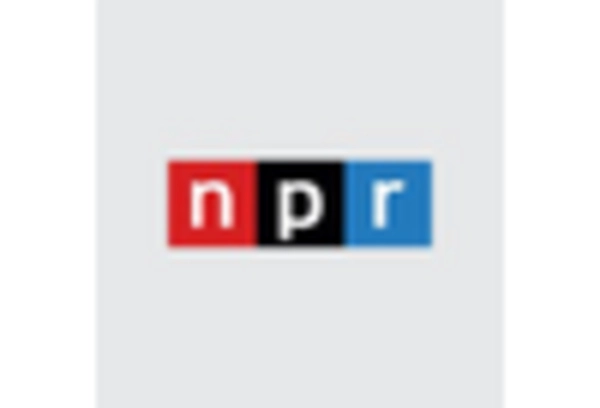Technological Integration
The Traditional Radio Advertising Market is increasingly influenced by technological advancements. The integration of digital platforms with traditional radio has opened new avenues for advertisers. For instance, the rise of streaming services and mobile applications has allowed radio stations to reach broader audiences. Data indicates that nearly 50% of radio listening occurs via digital platforms, which suggests a shift in how advertisers approach their campaigns. This technological convergence enables advertisers to utilize data analytics for targeted advertising, enhancing the overall effectiveness of their campaigns. Moreover, the ability to track listener engagement in real-time provides valuable insights, allowing advertisers to refine their strategies and maximize their return on investment.
Adaptation to Digital Trends
The Traditional Radio Advertising Market is adapting to the increasing prevalence of digital media. As consumers shift their attention to online platforms, radio stations are evolving to maintain relevance. This adaptation includes the incorporation of social media and podcasting, which allows advertisers to reach audiences in innovative ways. Recent statistics show that over 60% of radio listeners also engage with social media, indicating a potential synergy between traditional and digital advertising strategies. By embracing these trends, radio stations can offer advertisers multifaceted campaigns that leverage both traditional and digital channels. This adaptability not only enhances the effectiveness of advertising but also ensures that traditional radio remains a vital component of the overall media landscape.
Local Focus and Community Engagement
The Traditional Radio Advertising Market thrives on its ability to connect with local audiences. Advertisers often leverage radio's community-centric approach to reach specific demographics effectively. This localized focus allows businesses to engage with their target market in a more personal manner, fostering brand loyalty. According to recent data, approximately 75% of radio listeners report that they feel a strong connection to their local stations. This connection enhances the effectiveness of advertising campaigns, as consumers are more likely to respond to messages that resonate with their community. Furthermore, local events and sponsorships provide additional avenues for advertisers to engage listeners, thereby reinforcing the relevance of traditional radio in a rapidly evolving media landscape.
Cost-Effectiveness of Radio Advertising
The Traditional Radio Advertising Market is often viewed as a cost-effective option for advertisers. Compared to other media channels, radio advertising typically requires a lower budget, making it accessible for small and medium-sized enterprises. Data suggests that radio advertising can yield a higher return on investment, with some studies indicating that every dollar spent on radio can generate up to six dollars in sales. This cost-effectiveness is particularly appealing in a competitive market where businesses seek to maximize their advertising budgets. Additionally, the ability to create targeted campaigns that resonate with local audiences further enhances the value proposition of radio advertising, making it a preferred choice for many advertisers.
Regulatory Support and Industry Standards
The Traditional Radio Advertising Market benefits from a framework of regulatory support and established industry standards. Governments often recognize the importance of radio as a medium for public communication and community engagement. This recognition can lead to favorable regulations that support the growth of the industry. For instance, policies that promote local content and diversity in programming can enhance the appeal of radio advertising. Furthermore, adherence to industry standards ensures that advertisers can trust the integrity of the medium, fostering a stable environment for investment. As the industry continues to evolve, ongoing regulatory support will likely play a crucial role in shaping the future of traditional radio advertising.


















Leave a Comment